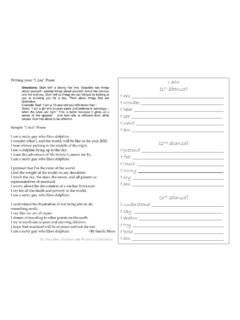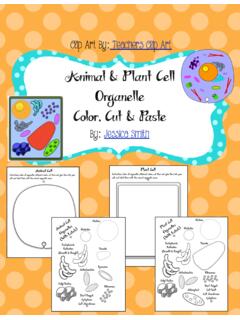Transcription of ORGANELLE LOCATION DESCRIPTION FUNCTION
1 ORGANELLE LOCATION DESCRIPTION FUNCTION cell wall plant, fungi and bacteria but not animal *outer layer *rigid, strong, stiff *made of cellulose *support (grow tall) *protection *allows H2O, O2, CO2 to pass into and out of cell cell membrane both plant/animal All cells *plant - inside cell wall *animal - outer layer; cholesterol *selectively permeable *support *protection *controls movement of materials in/out of cell *barrier between cell and its environment *maintains homeostasis Nucleus nucleus is absent in prokaryotic cells both plant/animal *large, oval generally . *controls cell activities *key ORGANELLE which has the genetic material and is involved in multiplication of cell, growth and maintenance of cell.
2 Nucleolus All cells except prokaryotes *Found inside cell s nucleus * may have more than one *disappears during cell division * Make ribosomes, contains building blocks or mRNA, tRNA, rRNA nuclear membrane both plant/animal *surrounds nucleus *selectively permeable *Controls movement of materials in/out of nucleus Centrioles Animal cells *paired structures near the nucleus *made of cylinder of microtubule pairs *stparate chromosome pairs during mitosis cytoplasm both plant/animal All cells *clear, thick, jellylike material (sytosol) * organelles found inside cell membrane *contains cytoskelon fibers *supports /protects cell organelles endoplasmic reticulum ( ) Smooth Rough both plant/animal *network of tubes or membranes No ribosomes Attached ribosome *carries materials through cell Synthesis of fats/lipids Ribosomes synthesis proteins for export ribosome both plant/animal *small bodies free or attached to *made of rRNA and protein *synthesizes proteins Mitochondria both plant/animal *bean-shaped *inner membranes Double membrane outer smooth inner folded into cristae *breaks down sugar molecules into energy *site of aerobic cellular respiration Golgi/golgi bodies / golgi apparatus both plant/animal except Prokaryotes These are the vacuoles or sac like structures.
3 They occupy a considerable amount of cytoplasm. *stacks of flattened sacs * to modify and package proteins for export *have cis and trans face vacuole plant - few/large animal - small *fluid-filled sacs * Vacuoles are pouches in the cell that store materials such as water, salts, proteins, and carbohydrates, waste products and toxic *store food, water, waste (plants need to store large amounts of food) Vesicles A lot of small bubble sacs in animals, large sac in the middle of plant cells These are small-sized sac like structures. They are of different types lysosomes, peroxisomes. *These help in storage and release of substances as required by the cell. For example lysosomes help in cell digestion when cell dies.
4 Vacuoles FUNCTION is to store water. lysosome plant - uncommon animal - common *small, round, with a membrane *breaks down larger food molecules into smaller molecules*digests old cell parts chloroplast plant, not animal *green, oval usually containing chlorophyll (green pigment) *uses energy from sun to make food for the plant (photosynthesis) Cilia Animal cells and protozoa Have a 9-2 arrangement of microtubules *short but numerous Movement of cell flagellum Bacteria cells and protozoan Sex cells *Have a 9-2 arrangement of microtubules *long but few in number movement Micro-tubules = cytoskeleton All cells *micro-tubules provide structural strength. * These are filamentous extensions in cytoplasm.
5 * the cell has a fixed structure and does not collapse * form the cyto-skeleton *moves organelles within the cell










